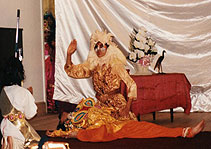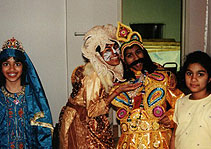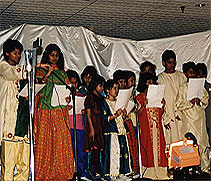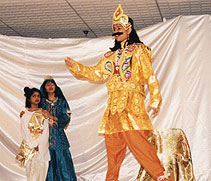 |
Report
of the Holi Program on March 25, 2000 |
| |
| |
 |
|
 |
| |
| |
 |
|
 |
| |
| |
 |
|
 |
|
| |
Contents |
 |
General Overview |
 |
Melana |
 |
Bhajan |
 |
Cultural Program |
| |
- Gitinatya: Bhakta Prahalada (by Children)
- Children Talent Show
- Drama: Jibanara Ranga (by Adults)
- Pala: Kitchaka Badha (by Pitamber Sarangi
as Gahana)
|
 |
Religious Discourse: Nrusingha
Chaitanyaji |
 |
Dinner |
 |
Memories: Video Recording and
Photographs |
 |
Cleaning |
| |
| |
Note: Holi program was arranged
by the Oriya Bhajan Group at Mangal Mandir Auditorium, 17110
New Hampshire Ave., Silverspring, MD. |
| |
|
 |
General
Overview |
| |
It was a great day for all of
us who participated in the program. The organizers reached
before time and made all the arrangements; but Hori
utchabara mauja adina megha deri karidelare.
It started raining at 3:30 pm when the Hori participants were
supposed to start driving from home; and the participants
reached late. The rain then stopped. It was God's wish and
we had no other way but accept His wish. The starting time
was still within the tolerance limit as compared to other
Indian functions and house dinner parties. This is the tendency
that needs to be changed, but it has historical significance
with Indian traditions.
In Gita it says: |
| |
karmani
ewa adhikArah te mA phaleshu kadAchana
mA karmaphalahetuh bhooh mA te sangah astu akarmani |
| |
" Thy
right is to work only; but never to its fruits; let not the
fruit of action be thy motive, nor let thy attachment be to
inaction. "
Although late, the program started smoothly with much excitement
and cheer and playing the colors. Many Families and singles
from 5 states participated. Our international participants
were Prof. and Mrs. Shrigopal Mohanty from Canada.
Our last year's lesson involved the place of the function
and this year we changed the place. Our this year's experience
gave us opportunity to understand the people and their values.
ajAgA ghA dekhi hue nAhin ki dekhAee hue nAhin
(wounds in private places are difficult to see and show others).
Our this year's experience is more significant and will guide
us for our future activities and involvements.
The rain, the distance, busy schedule, nothing had stopped
families from New Jersey and Philadelphia to reach on time
and participate in the Hori function. These true karmayogis
are Jaigopal Mohanty and Sulochana Mohanty, Sibaprasad and
Prachi Mohanty, Nitya Sundar and Twinkle Mahapatra, and Priya
Ranjan and Aparna Mahapatra. The karmayogis Pramod and Liza
Tripathy, and Sambit and Tanuja Dash drove on Friday night
to help on Hori arrangement and food preparation.
|
| |
|
 |
Melana |
| |
The first part of the
program was "Melana". Five "bimanas" had
arrived for the procession. They are: |
| |
- Radha-Krishna brought by mATA Karunamayi's family from
Silver Spring, Maryland
|
| |
- Lord Jagannath brought by Nrusingha Mishra's family
from Germantown, Maryland;
|
| |
- Radha-Krishna by Shrikant Nayak's family from Lanham,
Maryland;
|
| |
- Radha-Madan Mohan brought by Naresh Das's family from
Columbia, Maryland.
|
| |
The bimana's entered
the auditorium with kirtan and playing of color. The crowd
was cheerful. After all the bimana's reached the auditorium
stage, Madhumita Misra and Bandita Mishra did the "Arati".
Binod Nayak, Bandita Nayak joined them in singing the Arati
song (Jaya Jagadisha Hare). All the program participants came
near the Lords and did "bandApanA".
MATA Karunamayi's two beautiful daughters who are also ISKCON
devotees sang a Krishna bhajan.
Bedamati Das from Florida was at the registration desk distributing
the program schedule, name tags and the bhajan patrika. |
| |
Welcome Speech
Madhumita Misra delivered the welcome speech. Naresh
Das gave a short introduction about the function. |
| |
|
 |
Bhajan |
| |
The second part
of the program was bhajan which started just after everybody
finished doing "bandApanA".
Children's bhajan started after that. They sang sanskrit bhajan
"ohm shantakaram bhujaga
shayanam", Odia hori bhajan "ki
sundara aha ki Anandamaya se Radhamohana rupa"
and ended with "sarbe bhabantu
sukhina".
The Master of Ceremony for the bhajan program was Brahmapriya
Sen, who gave very nice introductions about the bhajan songs.
Bhajan by adults started with Deepa Parija. Deepa is a very
gifted singer with melodious tone and she has the ability
to sing both Odia and Hindi songs with excellent style. She
sang the bhajan "keun nAma dhari dakibi tumaku".
Surendra Ray accompanied her with harmonium and Naresh Das
with Mrudanga. Mahasringha Dasa accompanied with jhanja. The
other bhajan songs that followed are "brundabane ke banshi
bajaila" by Nrusingha Mishra, sambalpuri bhajan "Hai
Krushna Hai Krushna boli" by Padmanava Pradhan, hori
bhajan "Dekha Dekhalo sakhi netra bhari se mohanaku"
by Bigyani Das and jagannatha bhajan "Jaya Jagannatha
Swami" by Surendra Ray ( Surendra Ray is a very devoted
musician, a singer, harmonium player, mrudanga and tabla player).
The welcome song for Hori (Aji Asichhi re Asichhi hori paraba)
was presented by Deepa Parija, Sushim Dalabehera, Madhumita
Misra and Bigyani Das.
There was a surprise bhajan presentation by Abhinav Mahapatra.
|
| |
|
 |
Cultural
Program |
| |
Bikash Mishra and Tannuja Tripathy (Dash) were the masters
of ceremony for the cultural program.
The stage management, lights and sounds were taken care of
by Dhirendra Kar, and Nitya Sunder Mohapatra.
Gitinatya:
Bhakta Prahalada
The program started with Gitintya Bhakta Prahalada. The original
writer of this drama is ganakabi Baisnaba Pani. Basudeva Ratha
has given the "natyarupa" to this drama and the
audio cassette was made with well celebrated singers and actors
in Orissa. The performers were Bagmi Das (Hiranya Kashyapa),
Natasha Rao (The Queen), Siddhartha Mohapatra (Narada), Satish
Mishra (Indra), Mrunali Das (Brahma), Rajashri Mishra (Prahalada),
Prerana Pradhan (Teacher), Shashwati Das (Gurukula student),
Suman Ojha (Ghataka) and Sharmistha Mohapatra (Lord Narasingha).
The children did excellent job showing their understanding
far above their age level.
This drama is very significant as the Holi tradition comes
from this story signifying the death of Holika (Hiranya Kashyapa's
sister) who tried to kill Prahalada by sitting in fire with
Prahalada in her lap. The lesson from this drama proves the
fact that if God wishes to save somebody, nobody could cause
any harm.
The costumes for the drama were designed by the parents of
the performers. Sharmistha Mohapatra is also a gifted artist
who designed the Narasingha costume and Narada costume for
her role and her brother's role with help of her mother Sujata
(Meera) Mohapatra. She also painted the pillar. If you have
watched the drama, then you could have probably noticed the
talents within all these children. All the children have many
talents that stay hidden and they just need a medium to express
it. It's our duty to provide them the medium.
Shilpa Das and Shweta Das showed the act of generousity by
providing food to their friends who were performing and were
hungry. (Because of their involvement in their school drama
they could not participate in this drama). The generousity
came from within themselves and that's what we should encourage. |
| |
Children Talent Shows
The kathak dance by Srotalina Nayak was very beautiful. Srotalina
is a very gifted dancer.
The bhajan "jaya jagannatha swami" was presented
by Alok Mohanty. Alok is one of the child actor in the winning
skit presented during 1999 OSA convention in Toronto.
|
| |
Drama:
Jibanara Ranga
The drama "Jibanara Ranga" was performed
by our young members of Washington Oriya community. The story
was based on the real life of many computer professionals
who are single. They go through so much hardships and stress
in their jobs while they are also immotionally not yet settled
in this country. During this transition period, the love,
care and friendliness of other people in the community are
greatly needed. The skit was written by Hosensu Sahoo. He
was also the main director. Shrikanta Nayak's criticisms and
suggestions had added many improvements to the drama. Shrikanta
Nayak was the announcer for different scenes.
The performers were Hosensu Sahoo, Sushim Dalabehera and Shantanu
Das as computer professionals Rajesh, Ajaya and Sumit; Padmanava
Pradhan as "bhai" and Lipishree Nayak as bhauja.
The drama was enjoyed by all.
|
| |
Pala: Kitchaka Badha
The pala was performed by Pitamber Sarangi of New Jersey
as GAHANA.
Can you imagine a person who has been living in USA for
more than 15 years could do a pala as gahana in which he
had to remember and recite the greatest Odia literary creations
without using any English words?
That was our most celebrated Pitamber babu as gahana. His
style, his voice, his transitions were far more superior
than the palas presented even in Odisha. I personally appreciate
and congratulate Pitamber babu (a Physics toper) for his
excellent presentation and wish he keeps this tradition.
He recited a poem in which three planets, mangala (Mars),
shani (Saturn) and bruhaspati (Jupitor) were used to describe
the beauty of Draupadi (Sairindhri). The planet "mangala"
is red and that color is the color of Draupadi's lips. The
planet "shani" is black which is the color of
Draupadi's hair. The planet "bruhaspati" is fair
(white) which is the color of Draupadi's body.
For modern age poets this could be the following:
|
| |
pAna chhepa ranga otha sundara
koilA rangara kesha bahaLa
chuna ranga Tanu AhA ki shovA
mu Adhunika kabi barnibi kibA |
| |
Pitamber babu was accompanied by Durga Mishra, Naresh Das,
Nrusingha Mishra and temple priest Mahashringha Dasa.
|
 |
Religious
Discourse |
| |
The last item of
the Hori function was the religious discourse by Nrushingha
Chaitanyaji, the president of Baltimore ISKCON temple. Nrushingha
Mishra introduced him. It was late, so he spoke to us by reducing
his original planned speech. He picked up the pala Kitchaka
badha and emphasized the preservance of the culture through
all odds. He also told that Kitchaka died because of "kama",
a weakness that could take human to their end if not controlled
properly. He also mentioned about other destructive elements
such as anger, ego, jealousy, greed and attachments which
should be controlled. Although it's very difficult for the
common human being to completely get rid of these destructive
elements, they should be within control. Nrusingha Mishra
gave final thanks and announced the formal end of the Hori
function.
|
 |
Dinner |
| |
The major part
of the program, food, was managed by Urmila Sahu, Meera Mohapatra
and Illa Ojha.
They cooked the prasad for the function with the help of Pramod
Tripathy and Sambit Dash in Baltimore ISKCON temple kitchen.
They started their day in the kitchen and were in charge of
prasad distribution.
They had put tremendous effort to make everybody eat delicious
food and enjoy. Mrs Urmila Sahu had prepared gulab jamun
and bundi which the participants enjoyed. They had also
prepared cheese cake, and bhoga items at home. The other
people who contributed cooked items from home are Bandita
Mishra, Sikha Sen, Bigyani Das, Chandana Pradhan, Liza Tripathy
and Madhumita Misra.
There was no formal dinner time. Food was plenty and people
were eating all the time.
|
 |
Memories:
Video Recording and Photographs |
| |
Arun
Ojha has made video recordings of bhajan, drama, pala and
the ending. Nrusingha Mishra has made recordings of Hori
melana. The still pictures were taken by Koneti Rao and
Dibya Das.
All of these will be compiled.
|
| |
|
 |
Cleaning |
| |
Everybody participated
in the clean up. |
| |
|
| |
Author:
Dr Bigyani Das (bdas@bme.jhu.edu)
Last Updated:
05/02/2000
Reason: Original
Contact
No: (301) 498 3729 |
| |
|
| |
|
| |
|